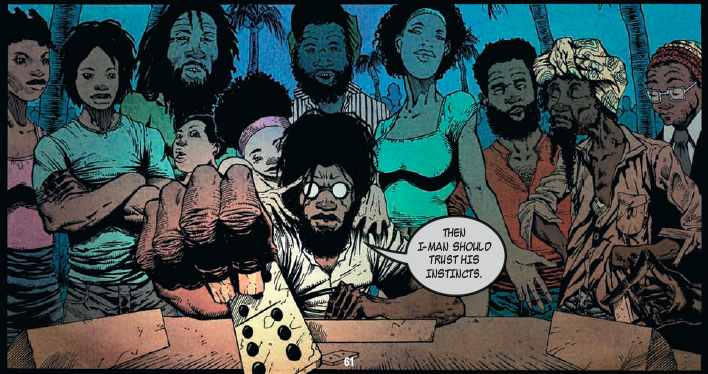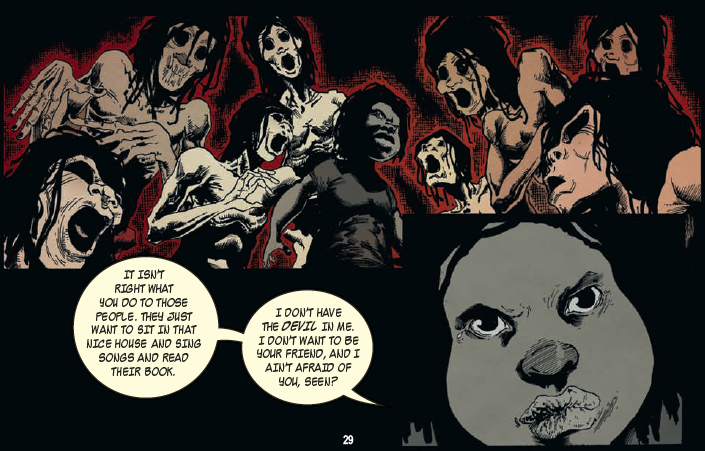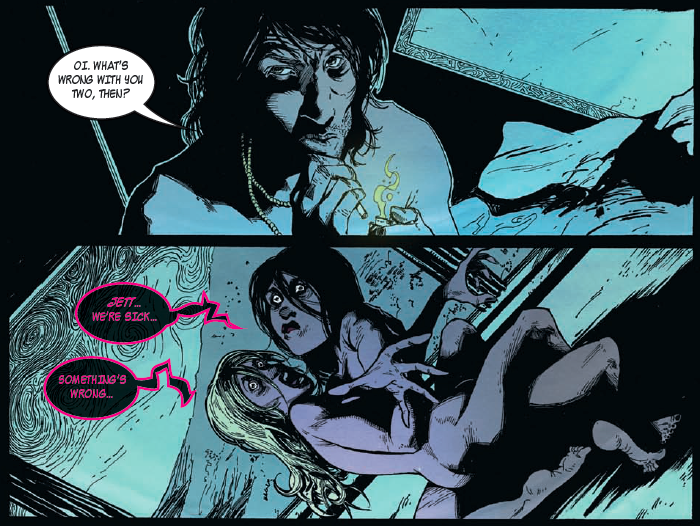Duppy '78
Warring gangs squabble for territory in Duppy '78, a new hallucinatory whirlwind of sometimes gory, drug trade-fueled violence and Jamaican ghost-story horror from UK publisher Com.X. Writer Casey Seijas sets this Caribbean yarn in the summer of 1978, a time when the island's state of considerable political unrest yielded a very public death of civilians at the hands of Jamaican soldiers. "In Jamaica, the two main political parties are irrefutably linked to the violent gangs which they armed and encouraged during the unrest in the 1970s," wrote The Guardian's Mark Oliver of the Jamaica Labor Party and the People's National Party in 2001. After having been promised jobs with the military, fourteen suspected members of local gangs in early 1978 were led to a shooting range where they'd been told to wait for transportation and a meeting about their potential employment opportunity. Instead, they were fired upon by a sniper squad and five of the men were killed. Incidents like the "Green Bay Massacre" signified the sort of violence that underscored Jamaica's political climate on all fronts back then, with neighborhoods like those in Kingston split into factions according to support of the political figures who encouraged and empowered local gangs to hold down voting blocs. While Seijas and Canadian artist Amancay Nahuelpan don't wade much into the region's stormy politics, the gang element is prominent, and Duppy '78 is grounded in Caribbean folklore and in the Rastafari movement, and is fitted with imagery and language specific to Jamaican culture. (A similar pairing of mythology and genre fiction is cast to visually striking effect in Com.X's Babble, about which I wrote for PopMatters in 2013.) One of the comic's more intriguing elements, however, is the part given to children in the book.
"In Jamaica, the two main political parties are irrefutably linked to the violent gangs which they armed and encouraged during the unrest in the 1970s," wrote The Guardian's Mark Oliver of the Jamaica Labor Party and the People's National Party in 2001. After having been promised jobs with the military, fourteen suspected members of local gangs in early 1978 were led to a shooting range where they'd been told to wait for transportation and a meeting about their potential employment opportunity. Instead, they were fired upon by a sniper squad and five of the men were killed. Incidents like the "Green Bay Massacre" signified the sort of violence that underscored Jamaica's political climate on all fronts back then, with neighborhoods like those in Kingston split into factions according to support of the political figures who encouraged and empowered local gangs to hold down voting blocs. While Seijas and Canadian artist Amancay Nahuelpan don't wade much into the region's stormy politics, the gang element is prominent, and Duppy '78 is grounded in Caribbean folklore and in the Rastafari movement, and is fitted with imagery and language specific to Jamaican culture. (A similar pairing of mythology and genre fiction is cast to visually striking effect in Com.X's Babble, about which I wrote for PopMatters in 2013.) One of the comic's more intriguing elements, however, is the part given to children in the book. A truce between local gang kingpins is compromised in Casey Seijas's dizzying, turbulent graphic novel, and it sets off a chain of battles and otherworldly unrest that eventually engulfs all of Kingston's major players -- the criminals, the bosses, a local businessman named Mansfield who uses his daughter Elena's volatile powers of communication and willpower to his advantage. Seijas gave an interview about his story to Robot 6 in January. He talked with writer Chris Arrant about the origin of "duppy," a Jamaican word that originated likely in Africa meaning ghost or spirit. Seijas shared a story about Jamaican reggae musician Peter Tosh, in whom he found inspiration for his book (Tosh performed at the enormous "One Love Peace Concert" in 1978 with Bob Marley and others).I had Heart of The Congos' "Children Crying" going on our turntable during a recent Sunday morning when I was digging into Seijas's work, and as children end up wielding so much power in this story, I haven't been able to avoid thinking about that record while looking over the notes I made for this post. "Children Crying" was one of the first entries tracked for Heart of the Congos, which was recorded by legendary producer Lee Perry in 1976 and 1977. The engineer's Washington Gardens studio digs were less than 20 minutes' drive from Trench Town, where Duppy '78 is set. Given the Peter Tosh connection that Seijas has made, I don't think the writer would quibble with my associating this record with his story. Singer Cedric Myton deals worshipful verses over "Children"'s jovial bass line, piano, and varied percussion, as well as the full dose of tape ribbon hiss and the rest of the intentional atmospherics (a child's "cow sound" toy?) that characterized Perry's experimental "dub" recordings of the era. "The entire sound is best described as aquatic," wrote Michael Veal of the LP in his DUB: Soundscapes & Shattered Songs in Jamaican Reggae. Perry, a self-identified "Duppy Conqueror," has over the years discussed a power he harbors to rid the world of evil spirits, and he reportedly destroyed his recording studios in 1979 to cleanse it of evil.
A truce between local gang kingpins is compromised in Casey Seijas's dizzying, turbulent graphic novel, and it sets off a chain of battles and otherworldly unrest that eventually engulfs all of Kingston's major players -- the criminals, the bosses, a local businessman named Mansfield who uses his daughter Elena's volatile powers of communication and willpower to his advantage. Seijas gave an interview about his story to Robot 6 in January. He talked with writer Chris Arrant about the origin of "duppy," a Jamaican word that originated likely in Africa meaning ghost or spirit. Seijas shared a story about Jamaican reggae musician Peter Tosh, in whom he found inspiration for his book (Tosh performed at the enormous "One Love Peace Concert" in 1978 with Bob Marley and others).I had Heart of The Congos' "Children Crying" going on our turntable during a recent Sunday morning when I was digging into Seijas's work, and as children end up wielding so much power in this story, I haven't been able to avoid thinking about that record while looking over the notes I made for this post. "Children Crying" was one of the first entries tracked for Heart of the Congos, which was recorded by legendary producer Lee Perry in 1976 and 1977. The engineer's Washington Gardens studio digs were less than 20 minutes' drive from Trench Town, where Duppy '78 is set. Given the Peter Tosh connection that Seijas has made, I don't think the writer would quibble with my associating this record with his story. Singer Cedric Myton deals worshipful verses over "Children"'s jovial bass line, piano, and varied percussion, as well as the full dose of tape ribbon hiss and the rest of the intentional atmospherics (a child's "cow sound" toy?) that characterized Perry's experimental "dub" recordings of the era. "The entire sound is best described as aquatic," wrote Michael Veal of the LP in his DUB: Soundscapes & Shattered Songs in Jamaican Reggae. Perry, a self-identified "Duppy Conqueror," has over the years discussed a power he harbors to rid the world of evil spirits, and he reportedly destroyed his recording studios in 1979 to cleanse it of evil.
"The children crying in the wilderness / Send us a prophet, to warn the nation / All the children in this creation, All the people that you see / Will be the children of the Most High"
Children are cast in a starring role in Duppy '78 — they're the sole conjurers of the book's wealth of apparitions. The spirits are drawn to rich effect by Amancay Nahuelpan, whose approach is reminiscent of artist Eduardo Risso -- Risso's work on Vertigo's long-running urban crime drama 100 Bullets definitely seems to have had an impact on Nauelpan's action sequences (and Seijas is an ex-Vertigo editor). But the voodoo-driven horror that frames a lot of Duppy's panels is distinctive and psychedelic, with Nahuelpan's scratchy red swaths outlining grotesque undead figures, the kind of thing that's far removed from the darkened barrooms that fill the pages of 100 Bullets. Supernatural overtones mark Duppy '78 early on, when a boy in a wheelchair named Judah is ushered into a barren room during an interrogation scene between local crime boss Johnny Too Bad and an underling who's failed him. One of the panels suddenly hosts a trio of eyeless ghosts lurking behind the child. After a shotgun is discharged, we get a good, long look at the ghouls. Nahuelpan's expository work here is chilling, comprised of a mash of things that typically defines your average everyday nightmare for someone Judah's age. On a single page, there's the perspective of Too Bad, of Judah, and a full shot of five duppies dancing in puddles of blood. Pig innards are strewn across the wooden floor, where the dead gang member is sprawled out amid rats, snakes, and spiders. Arachnid-fired imagery is used later, when Nahuelpan fuses the naked bodies of two stoned groupies in a rock star's hotel suite.
Supernatural overtones mark Duppy '78 early on, when a boy in a wheelchair named Judah is ushered into a barren room during an interrogation scene between local crime boss Johnny Too Bad and an underling who's failed him. One of the panels suddenly hosts a trio of eyeless ghosts lurking behind the child. After a shotgun is discharged, we get a good, long look at the ghouls. Nahuelpan's expository work here is chilling, comprised of a mash of things that typically defines your average everyday nightmare for someone Judah's age. On a single page, there's the perspective of Too Bad, of Judah, and a full shot of five duppies dancing in puddles of blood. Pig innards are strewn across the wooden floor, where the dead gang member is sprawled out amid rats, snakes, and spiders. Arachnid-fired imagery is used later, when Nahuelpan fuses the naked bodies of two stoned groupies in a rock star's hotel suite. It's an awfully nasty hallucination here, with Nahuelpan augmenting an already palpable air of witchery via pooling blood and a backdrop of black fluid swirls that mirror late 1960s-era West Coast psychedelic concert poster art. The swirls in his linework are apparent as soon as the sequence opens — the sky outside the hotel room is suddenly rife with motion, and sinister black spirals make their way across the wall interiors. Things don't end well for the stringy haired rocker, and unlikely as it seems, it's at the hands of cherubic-faced Elena, a small, seemingly gentle soul in a story that's otherwise about big, bad people.Duppy '78 is available via Comixology. All images © 2014 Com.X.
It's an awfully nasty hallucination here, with Nahuelpan augmenting an already palpable air of witchery via pooling blood and a backdrop of black fluid swirls that mirror late 1960s-era West Coast psychedelic concert poster art. The swirls in his linework are apparent as soon as the sequence opens — the sky outside the hotel room is suddenly rife with motion, and sinister black spirals make their way across the wall interiors. Things don't end well for the stringy haired rocker, and unlikely as it seems, it's at the hands of cherubic-faced Elena, a small, seemingly gentle soul in a story that's otherwise about big, bad people.Duppy '78 is available via Comixology. All images © 2014 Com.X.